Indonesia Solar Energy Market Size
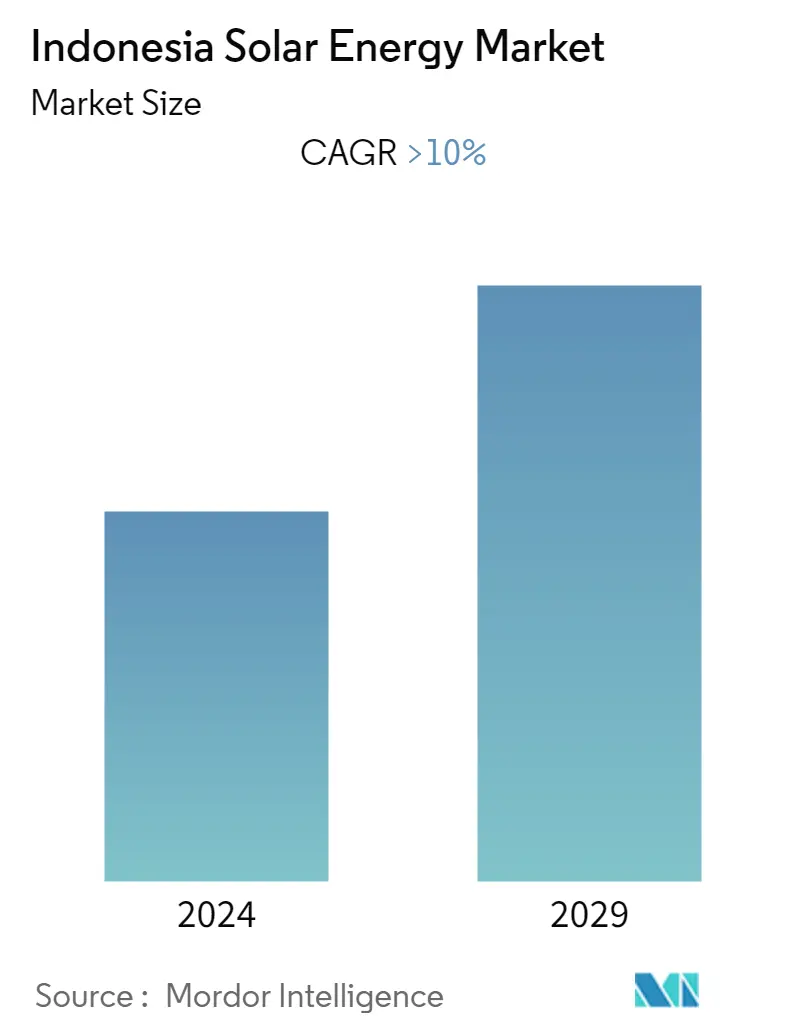
| Study Period | 2020 - 2029 |
| Base Year For Estimation | 2023 |
| Forecast Data Period | 2024 - 2029 |
| Historical Data Period | 2020 - 2022 |
| CAGR | 10.00 % |
| Market Concentration | Medium |
Major Players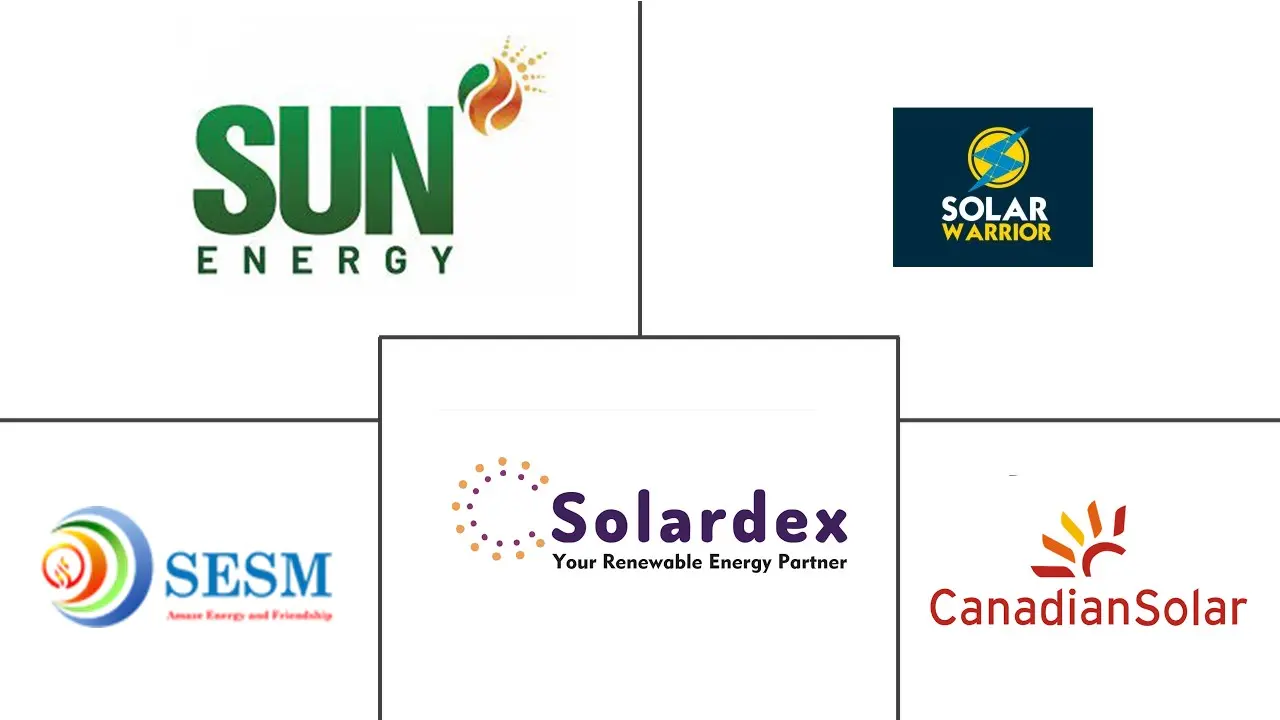
*Disclaimer: Major Players sorted in no particular order |
Indonesia Solar Energy Market Analysis
The Indonesia solar energy market is expected to register a CAGR of more than 10% during the forecast period.
COVID-19 negatively impacted the market in 2020. Presently the market is likely to reach pre-pandemic levels.
- Over the medium term, factors like increasing demand for renewable energy due to developmental activities and decreasing cost of solar PV technology are expected to drive the market.
- On the other hand, heavy dependency on fossil fuels to meet the energy demand is a significant restraint hindering the market's growth.
- Nevertheless, the increasing concern over environmental emission control, which leads to the premature retirement of existing coal power plants, is expected to create enormous opportunities for Indonesia's solar energy market.
Indonesia Solar Energy Market Trends
This section covers the major market trends shaping the Indonesia Solar Energy Market according to our research experts:
Off-Grid Segment Expected to Witness Significant Growth
- Indonesia is a populous country with a distinctive terrain, having over 17,508 islands. The distributed topography of the country poses a substantial difficulty to the country's power sector. Around 40% of off-grid regions are primarily located outside Java island and are unlikely to be accessible by the national grid.
- Solar PV growth has been a relatively small component of the energy mix in recent years. Most current solar development activity comprises stand-alone solar PV systems located in distant areas and some bigger capacity on-grid systems.
- According to International Renewable Energy Agency, Indonesia's total off-grid installation capacity was 67.59 MW in 2021 compared to 43 MW in 2017, registering a growth rate of 11.4% yearly. The growth rate is expected to increase during the forecasted period.
- The electrification ratio of Indonesia has been planned to increase to 99.7% by 2025. The Indonesian government is pushing forward with plans to electrify rural areas of the country using new and renewable energy, and PV mini-grids are considered the least-cost option for the electrification of rural areas.
- Moreover, in November 2022, The International Renewable Energy Agency (IRENA) estimated that solar could become the backbone of Indonesia's energy system by 2030. According to their latest report, "Indonesia Energy Transition Outlook." Solar is expected to become the backbone of this transformation, accounting for 798 GW of the total 1,000 GW. PV accounts for up to 840 GW of the total solar installations. The majority of installations are expected to be off-grid due to geographical challenges.
- For instance, in November 2022, Saudi energy firm ACWA Power announced that they had secured a contract from the Indonesian state-owned utility PT Perusahaan Listrik Negara (PLN) to build two floating solar photovoltaic (PV) power projects. The contract covers the 60MWac Saguling project and Singkarak, a floating solar project with 50MWac capacity. The two projects will have a combined capacity of 110MWac and be built with a total investment of USD 105 million.
- Over the past years, the government has launched several programs and projects for solar PV deployment to supply electricity to un-electrified villages or replace diesel-based generation in remote regions. This strengthens the case for large-scale usage of the off-grid solar energy segment.
- Therefore, based on the factors mentioned above, the off-grid segment is expected to witness significant growth in the Indonesian solar energy market during the forecast period.
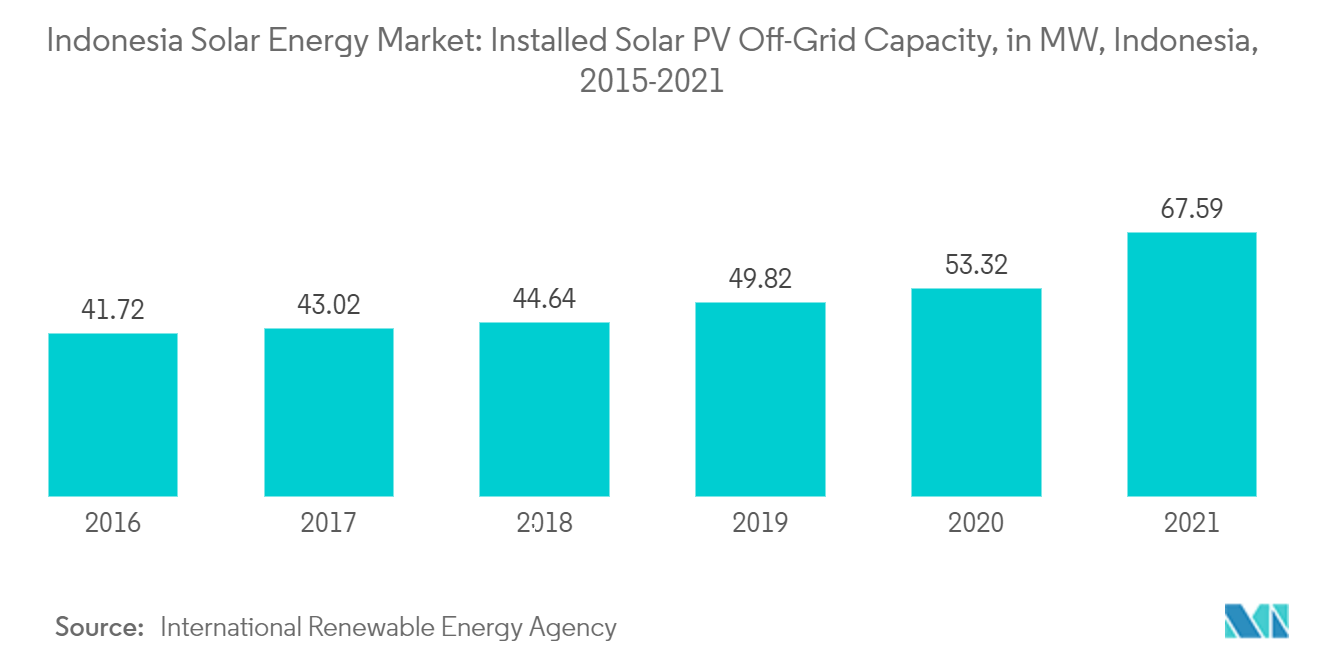
Alternative Renewable Energy Sources Restraining the Market Demand
- Indonesia is naturally endowed with renewable energy sources, particularly wind energy. According to Asia Wind Energy Association, the average wind speeds in Indonesia range from 1.3 to 6.3 m/s. The main wind energy potential lies in East and West Nusa Tenggara, which have average wind speeds of more than five m/s. The approximate wind power potential in Indonesia is estimated to be 9.5 GW.
- According to the Ministry of Energy and Mineral Resources, as of 2021, the wind power installed capacity stood at 154 MW. However, the country has plans to install 1.8 GW of wind energy by 2025.
- In March 2022, French Development Agency signed an agreement with PLN development of a 200 MW wind farm in Pandeglang, Banten. The construction will likely begin in 2022, and commercial operations are expected by 2025.
- Other than wind energy, in September 2022, Indonesia's state utility company PT Perusahaan Listrik Negara (PLN) announced that the company had started the construction of USD 850 million 1040 MW hydro-power plant in West Jawa part of Indonesia to increase the renewable power contribution to its energy mix. The power plant is expected to come online in 2027.
- Such alternative renewable energy projects shave off solar energy in the country's renewable energy mix, thus, restraining the market growth.
- Thus, considering the points mentioned above, alternative renewable energy sources are likely to hamper the country's solar energy market growth during the forecast period.
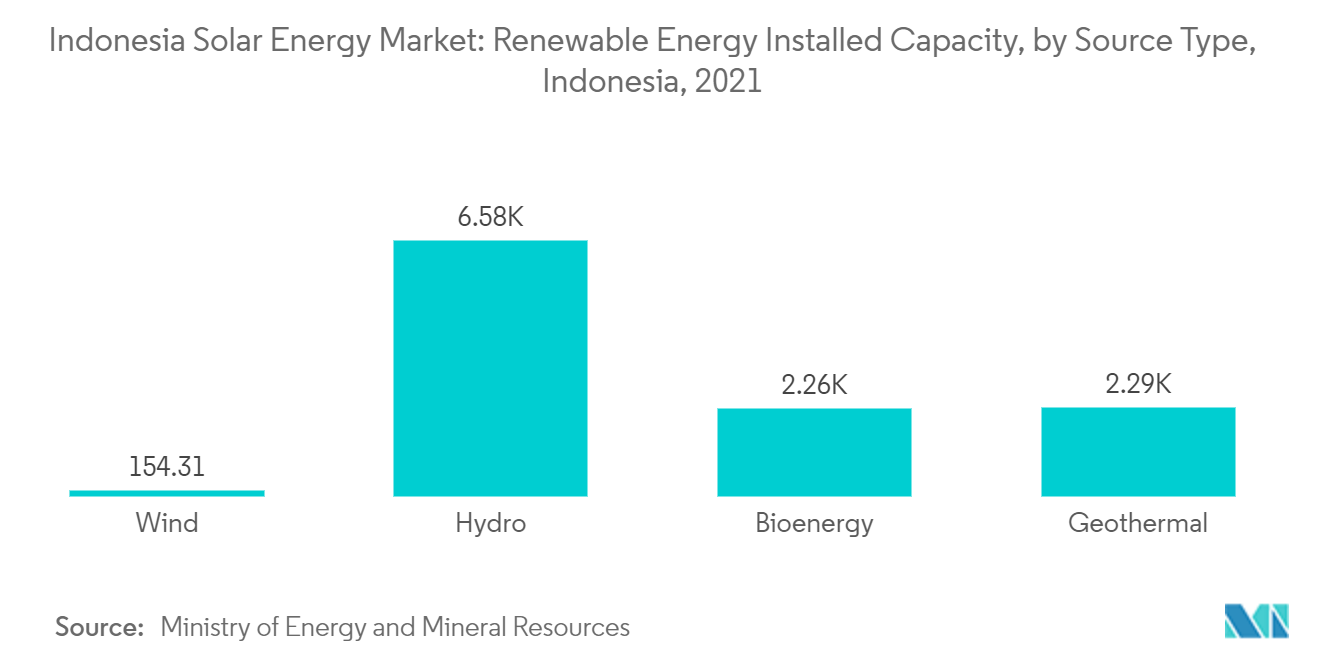
Indonesia Solar Energy Industry Overview
The Indonesia solar energy market is moderately fragmented. Some of the major players in the market (in no particular order) include Canadian Solar Inc. and PT. Surya Utama Nuansa, PT Solardex Energy Indonesia, PT. Sumber Energi Surya Nusantara, and PT Sumber Energi Sukses Makmur.
Indonesia Solar Energy Market Leaders
-
PT Sumber Energi Sukses Makmur
-
PT Solardex Energy Indonesia
-
Canadian Solar Inc.
-
PT. Sumber Energi Surya Nusantara
-
PT. Surya Utama Nuansa
*Disclaimer: Major Players sorted in no particular order
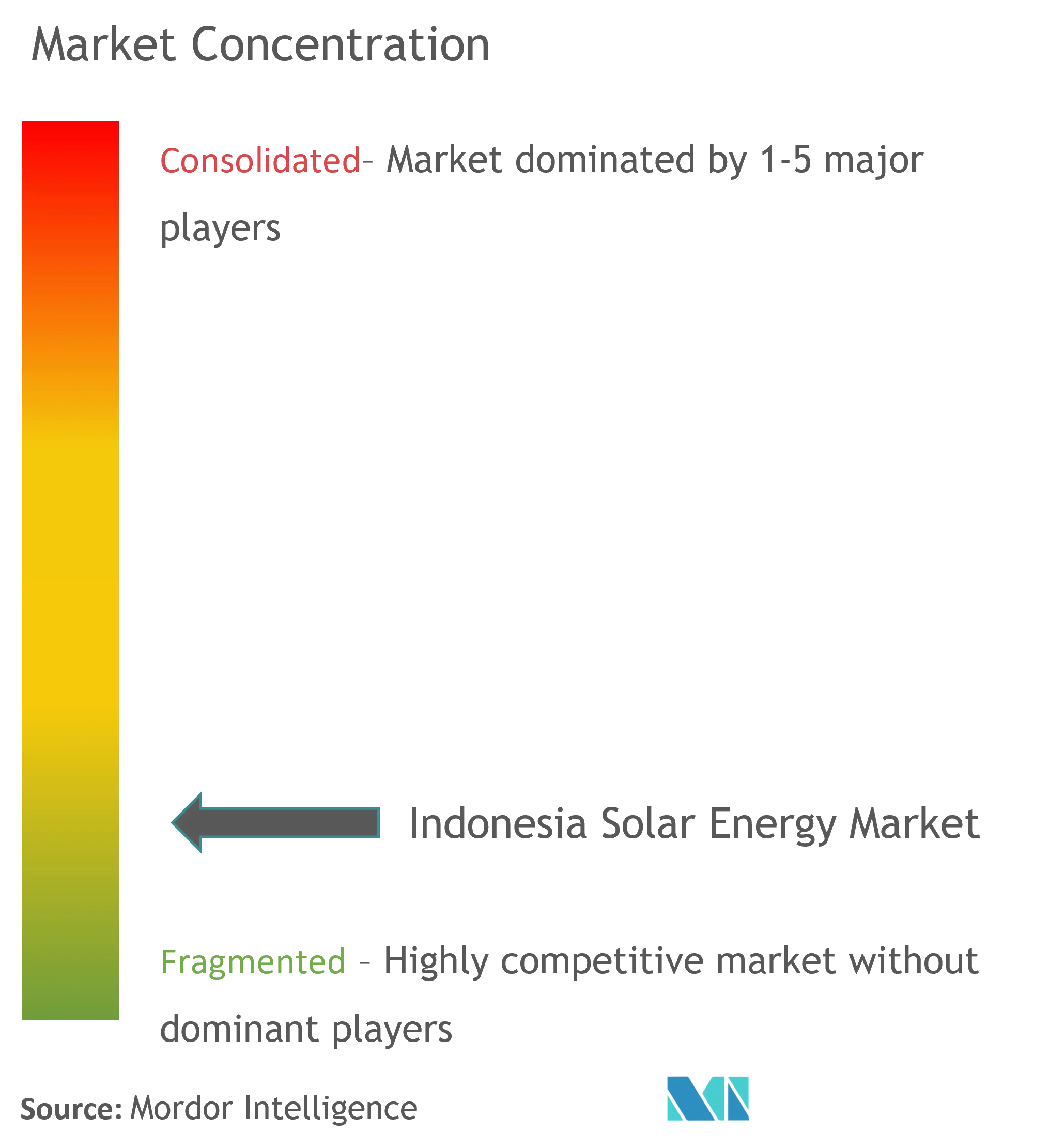
Indonesia Solar Energy Market News
- In December 2022, on behalf of the German Federal Ministry for Economic Cooperation and Development (BMZ), KfW signed a financing agreement with the Indonesian Ministry of Finance for a promotional loan of USD 285 million for the Sustainable and Inclusive Energy Programme (SIEP, Phase III). The financed package of measures includes reforms to promote renewable energies, such as improved price mechanisms for feed-in tariffs, regulation for rooftop solar power systems, or more ambitious energy efficiency standards.
- In March 2022, Beiersdorf AG entered into a long-term solar power deal with TotalEnergies SE involving a solar rooftop project in Indonesia. The plant will be a 540-kWp solar PV array on top of a manufacturing site to generate 830 MWh of electricity per year to meet 20% of the plant's needs.
- In January 2022, Masdar signed an agreement with Tuas Power, EDF Renewables, and PT Indonesia Power to develop solar PV plants with a capacity of up to 1.2 GW in Indonesia.
Indonesia Solar Energy Market Report - Table of Contents
1. INTRODUCTION
- 1.1 Scope of the Study
- 1.2 Market Definition
- 1.3 Study Assumptions
2. EXECUTIVE SUMMARY
3. RESEARCH METHODOLOGY
4. MARKET OVERVIEW
- 4.1 Introduction
- 4.2 Renewable Energy Mix, Indonesia, 2021
- 4.3 Solar Energy Installed Capacity and Forecast, in GW, till 2028
- 4.4 Recent Trends and Developments
- 4.5 Government Policies and Regulations
-
4.6 Market Dynamics
- 4.6.1 Drivers
- 4.6.2 Restraints
- 4.7 Supply Chain Analysis
- 4.8 PESTLE Analysis
5. MARKET SEGMENTATION - BY CONNECTION
- 5.1 On-grid
- 5.2 Off-grid
6. COMPETITIVE LANDSCAPE
- 6.1 Mergers and Acquisitions, Joint Ventures, Collaborations, and Agreements
- 6.2 Strategies Adopted by Leading Players
-
6.3 Company Profiles
- 6.3.1 Canadian Solar Inc.
- 6.3.2 Trina Solar Co. Ltd
- 6.3.3 TotalEnergies SE
- 6.3.4 PT. Sumber Energi Sukses Makmur
- 6.3.5 PT. Solardex Energy Indonesia
- 6.3.6 PT. Surya Utama Nuansa
- 6.3.7 PT. Sumber Energi Surya Nusantara
- 6.3.8
- *List Not Exhaustive
7. MARKET OPPORTUNITIES AND FUTURE TRENDS
** Subject To AvailablityIndonesia Solar Energy Industry Segmentation
The energy utilized from the radiation of the sun's heat is called solar energy. Solar energy is either directly used in the form of heat or is converted into electricity through various technologies. It mainly consists of two types of technologies, solar photovoltaic and concentrated solar power.
The Indonesia Solar Energy Market is segmented by Connection Type. By connection type, the market is segmented into On-Grid and Off-grid. For each segment, the market sizing and forecasts have been done based on installed capacity in gigawatts (GW).
Indonesia Solar Energy Market Research FAQs
What is the current Indonesia Solar Energy Market size?
The Indonesia Solar Energy Market is projected to register a CAGR of greater than 10% during the forecast period (2024-2029)
Who are the key players in Indonesia Solar Energy Market?
PT Sumber Energi Sukses Makmur, PT Solardex Energy Indonesia, Canadian Solar Inc., PT. Sumber Energi Surya Nusantara and PT. Surya Utama Nuansa are the major companies operating in the Indonesia Solar Energy Market.
What years does this Indonesia Solar Energy Market cover?
The report covers the Indonesia Solar Energy Market historical market size for years: 2020, 2021, 2022 and 2023. The report also forecasts the Indonesia Solar Energy Market size for years: 2024, 2025, 2026, 2027, 2028 and 2029.
What are the Challenges facing the Indonesia Solar Energy Market?
The Challenges facing the Indonesia Solar Energy Market are a) High upfront costs of solar panel installations b) Limited grid connectivity in remote areas c) Technological limitations: energy storage and efficiency d) Lack of awareness about solar energy benefits
What are the Opportunities in the Indonesia Solar Energy Market?
The Opportunities in the Indonesia Solar Energy Market are a) Off-grid solar solutions for remote areas b) Rooftop solar potential in urban areas c) Industrial and commercial applications d) Energy storage solutions
Indonesia Solar Energy Industry Report
The Indonesia solar energy market is poised for significant growth, driven by the increasing demand for renewable energy and the decreasing cost of solar PV technology. Challenges such as heavy dependence on fossil fuels and competition from other renewable sources like wind and hydro-power could restrain growth. Nonetheless, the off-grid segment is expected to see substantial growth due to Indonesia's unique geographical challenges, with many islands unlikely to be connected to the national grid. Efforts to increase the electrification ratio and government initiatives promoting solar PV installations in remote regions are poised to bolster this segment significantly. Meanwhile, the market benefits from increasing environmental awareness and emission control efforts that lead to the retirement of coal power plants, creating more room for solar expansion. The market is moderately fragmented, with significant players pushing the adoption of solar technology across various sectors. It is categorized based on connection type into on-grid and off-grid, each showing distinct dynamics influenced by national energy policies and infrastructural developments. For detailed statistics about the Indonesia Solar Energy market size, share, revenue growth, and a market forecast outlook, refer to Mordor Intelligence™ Industry Reports offering a comprehensive analysis and a free report PDF download.



